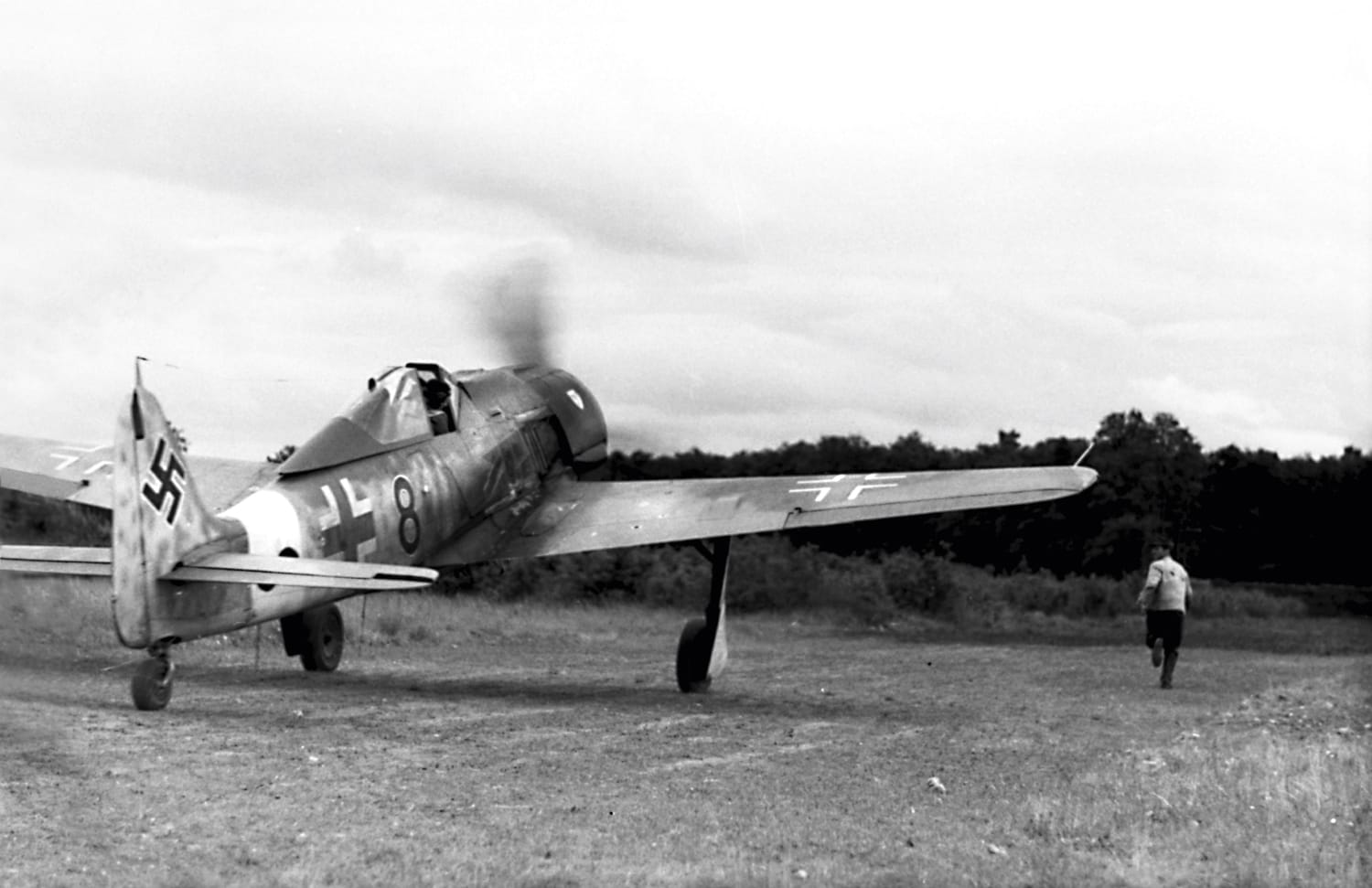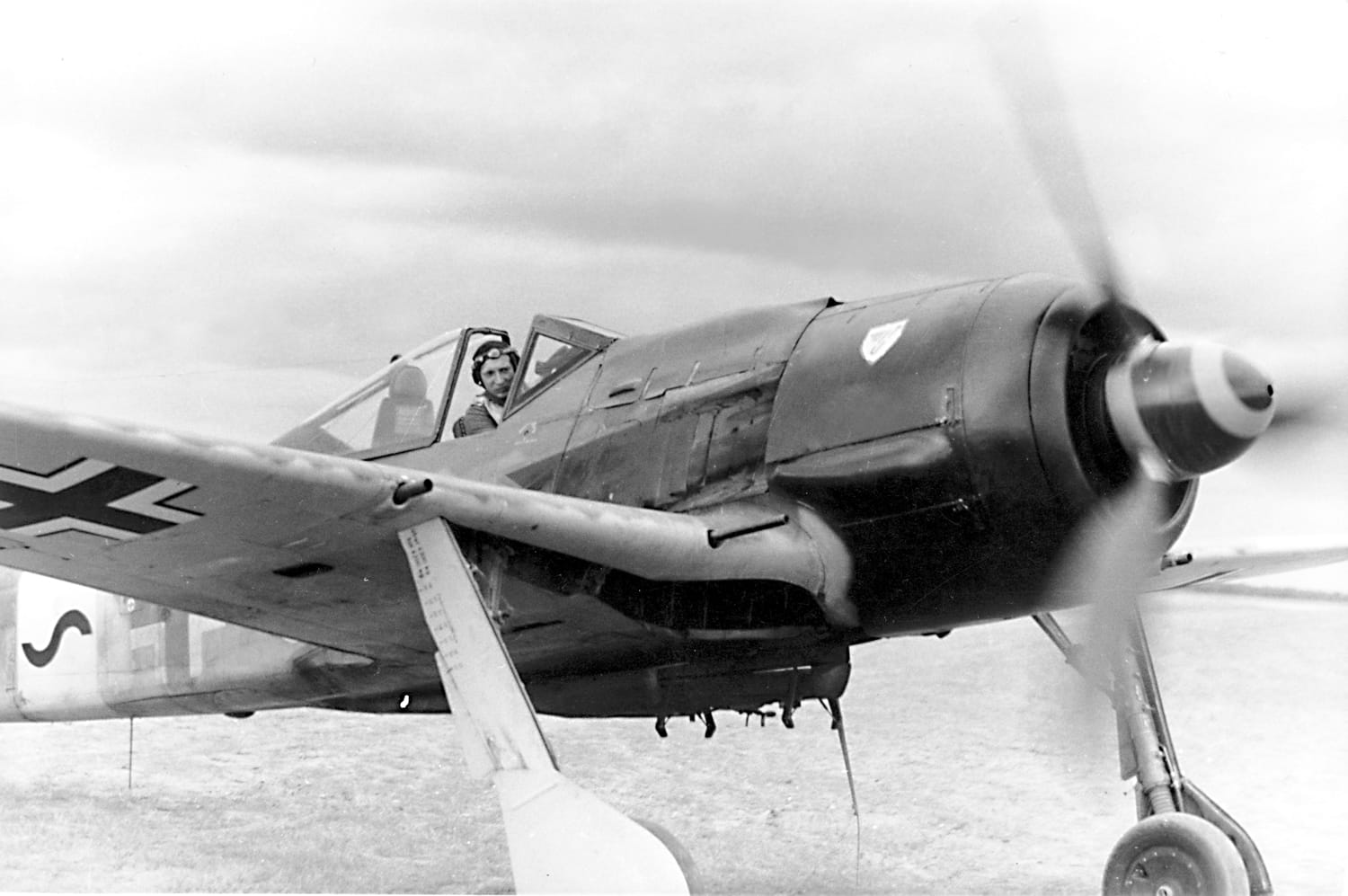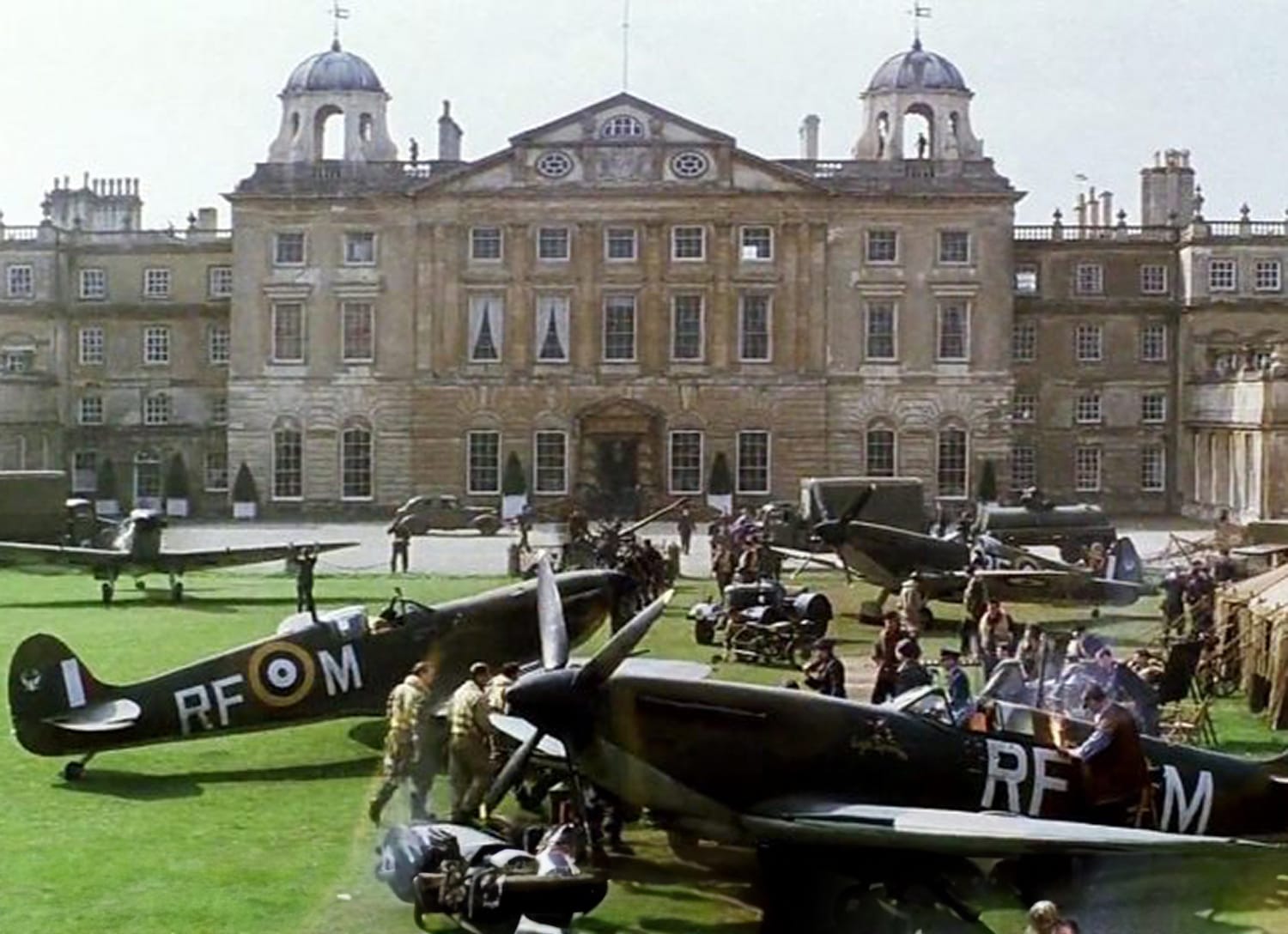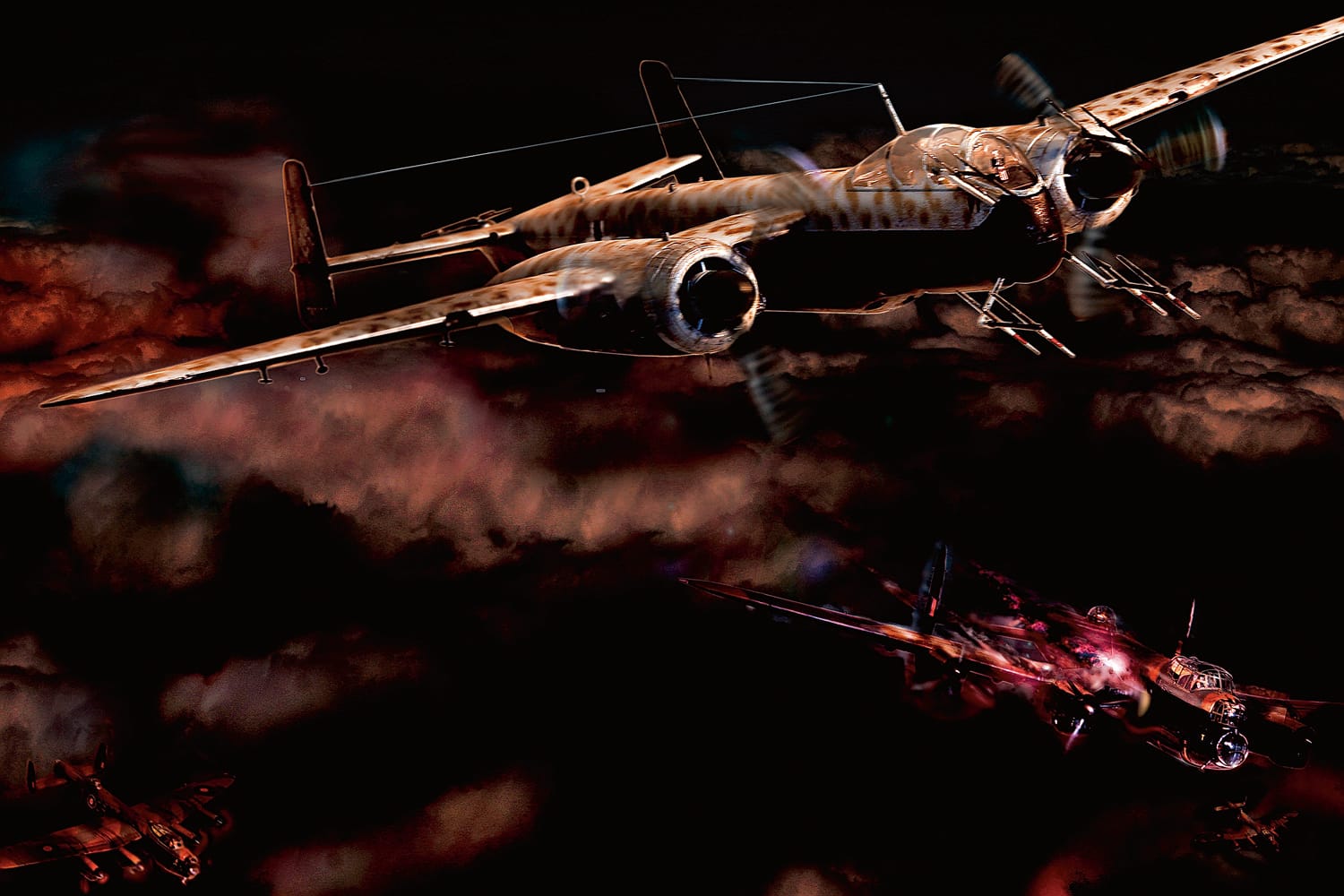Sturmjäger – cuirassiers of the air
Air battle over Germany: the attack on hydrogenation plants and aircraft factories
In the early hours of the morning of 7th July 1944 756 B-17 Flying Fortress bombers and 373 B-24 Liberators took off with heavy fighter protection (756 allied fighters) for an attack on the hydrogenation plants at Leuna and Böhlen, and the aircraft factories at Leipzig, Halle and Bernburg. The Sturmgruppen (“storm groups“) of II./JG 300 and IV./JG 3 (mainly Focke-Wulf 190 A-8/R2s) as well as two covering Gruppen of JG 300 (Me 109 G-6s) launched themselves—along with II./JG 5 and I. and II./ZG 26—at the 1,885 strong US aircraft formation. There were 199 defenders against 1,885 intruders. Apart from 11 B-17s the USAAF also lost 29 B-24 Liberator bombers, the majority of which were during the devastating attack of the 44 Sturmjäger of IV./JG 3 near Bernburg. 492nd Bomb Group alonelost twelve of their B-24 Liberators in only thirteeen minutes. The attack was led by Hauptmann Wilhelm Moritz. IV.(Sturm)/JG 3 along with 2./JG 51 had five fewer aircraft after the air battle, four German pilots across both units lost their lives.
The “Sturmjäger” (storming hunters) – a German elite unit

7th July 1944
The Sturmjäger or also “Rammjäger“ as they were sometimes called (“ramming fighters“) of JG 3 were a German elite unit which was feared by American bomber crews. Their missions which were flown in close formation demanded nerves of steel. In every mission they planned to force at least one enemy bomber to crash, even by ramming if necessary. However the intention was not suicide. In order to have the chance of surviving such a manoeuvre the pilots flew especially armoured Focke-Wulfs. In the majority of cases it never came to this, though, since the hail of 20 mm rounds from the inboard wing cannon and of the 30 mm cannon shells of the outboard weapons would be sufficient.
Concentrated assault from behind: the tactics of the Sturmjäger

In contrast to what was then the classic frontal attack on bombers, which often only allowed the attacking fighter a short period of time in which to aim and fire (although it was often enough) but also only exposed him briefly to the concentrated defensive fire of the bombers, the Sturmjäger mostly attacked from the rear. In this case their only advantage was the difference in speed, whereas in the case of a frontal attack the speed of the two opponents would be added. As the fighters flew in close formation, side by side, the bombers were no longer able to cover each other and concentrate their fire on one attacker. Each was forced to look after himself and deal with his own individual opponent. Nevertheless the fighters had to fly through a veritable hail of bullets and, if they managed to get close to the bomber, fire from point-blank range. The subsequent effect, particularly of the outboard 30 mm cannon (Mk 108), on the Flying Fortresses was tremendous.
In comparison with the normal fighter version of the Focke-Wulf 190 A-8 the Sturmjäger was drastically modified. The Sturmjäger A-8/R2 version, compared to the purely fighter A-8 variant, had a reinforced armour plating, which increased its weight by 440 lbs and protected it, particularly at the front, very effectively against the defensive fire of the bombers’ guns. The losses among the Sturmjäger to the machine gun fire of their four-engined enemies were therefore kept within “acceptable“ levels.
The bomber gunners, who could see a veritable phalanx of fighter aircraft advancing implacably on them from the rear in stoic and highly menacing formation, often fired nervously from as far away as 1,200 yards. Those American crews who were of a tougher nervous disposition would hold off until some 600 yards at the latest before unleashing the full force of their curtain of fire. It must have made them feel very uneasy, especially the tail gunners, when they realised that their concentrated defensive fire did not force the German fighter aircraft to undertake any evasive measures whatever. Instead the latter maintained a steady course with their cannon aimed menacingly at them, as if their own bullets were not even there, as death came relentlessly ever closer.
Optimised armament
The weight of the A-8/R2 in respect of the standard A-8 was further significantly increased by the different armament. The outboard, midspan 20 mm cannon (MG 151) were replaced by the heavy Mk 108 30 mm weapon, while the inboard MG 151s at the wing roots remained unchanged. Instead, in general, the 13 mm MG 131s which were usually installed on the engine cowling were removed. Their ammunition supply amounted to 475 shots per round, sufficient for 32 seconds of sustained fire. On the other hand the ammunition for the 20 mm MG 151s at the wing tips (250 rounds per gun) would be expended after only 22 seconds, while the magazines of the destructive 30 mm Mk 108 (55 rounds per gun) were barely sufficient for 5.5 seconds of sustained fire. The pilot of a standard Focke-Wulf 190 A-8 fighter would usually fire with the machine guns first and only when the bullets had clearly struck home would he employ the A-8’s four 20 mm cannon with the smaller ammunition supply. This targeting option did not apply to the Sturmjäger because of the absence of the MG 131. That is the reason why the elite pilots of the Sturmgruppen would fly though the hail of fire, closing to within a maximum of 400 or so yards of their gigantic enemy before opening fire—only then could they be relatively sure of a direct hit—initially with the two 20 mm cannon. If they achieved their full effect and actually hit the bomber, the two 30 mm weapons would be added from a maximum distance of 220 yards, therefore at point-blank range, and fired in short bursts to save ammunition. Their explosive shells would then tear whole chunks from the fuselage and wings of the targeted bomber.
Courageous approach and opening fire

It required enormous composure to fly in a close v-formation of fighter aircraft wingtip to wingtip, followed by a second wave, and to hold position in the fighter formation come hell or high water required an iron will and unflappability. How difficult it was for a pilot not to be deterred in the slightest by the bursts of tracer fire flashing towards him from dozens of double-barrels, but instead to fly through the cauldron without even the merest movement of his wings. He would then unmistakeably target his bomber, so that the comrade beside him would be able to spot which bomber was still available for himself, and finally let the bomber have it from all barrels at point-blank range—and all this after probably having caught a packet several times in his own aircraft!
It was only in the final phase of the attack that the German formation, in respect of the position of each Sturmjäger, adapted itself to the stacked manoeuvring of the bomber combat boxes—inevitably, since now every single bomber within the formation had a fighter on its tail with all guns blazing.
Challenges against enemy escort fighters
Their success was self-evident, provided the battle was against the designated target, the heavy four-engined “terror“ bomber. However woe betide the Sturmjäger if they had to deal with enemy escort fighters. At an altitude of 26,000 feet even the fighter variant of the Focke-Wulf 190 was considerably inferior to an American Mustang in terms of agility and speed (at lower altitudes an “ordinary“ Focke-Wulf 190 A-8 was more or less on a par with the Mustang). A cumbersome Sturmjäger had scarcely any hope at all against allied escort fighters at those altitudes. The Messerschmitt Bf 109 G-6 put up a far better show, although even in this case it needed to wait for distinctive design improvements until the G-10 and especially the K-4 variant were introduced, before it achieved technical parity.
There was an oath which was taken by all the pilots of IV.(Sturm)/JG 3 in the presence of their Kommodore, although it was rather more like a declaration of intent. “We swear to fight in the defence of the Reich according to the principles and the rules of engagement of the Sturmgruppe. As pilots of the Sturmgruppe we know that we have been called upon especially to protect and defend the people of our homeland to the extreme limits of our ability. We pledge to carry out the attack in each mission which involves the four-engined bombers at point-blank range and – if the effect of our gun armament is insufficient to successfully shoot down the bomber – to destroy the enemy aircraft by ramming it.“

Fighter/bomber performance tables






Ebenfalls interessant…

The final kill of the ace of aces, Erich Hartmann, the most successful fighter pilot of all time
Dangerous encounter in the airIn March 1945 a Russian bombing attack on Prague was reported. Hartmann took off with four Me 109s. A Russian formation…
Weiterlesen
That’s how historic air battles get botched by Hollywood
Time and again the ignorance and nonchalance with which even highly renowned directors simply ignore historic details is fascinating. They do this in spite of…
Weiterlesen
The night fighter He 219 “eagle owl” – the misjudged genius
In the year 1943 Germany was under pressure on all fronts, even on the so-called home front. Air Chief Marshal Arthur Harris, Commander-in-Chief of the…
Weiterlesen